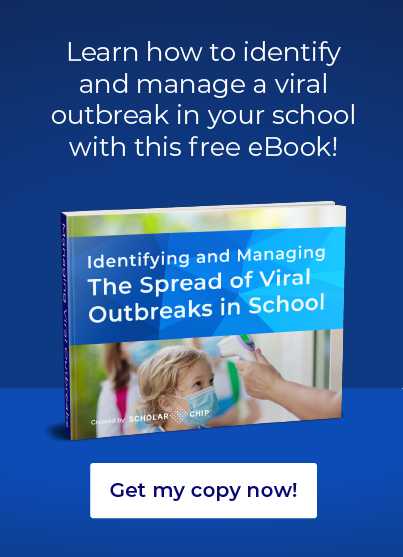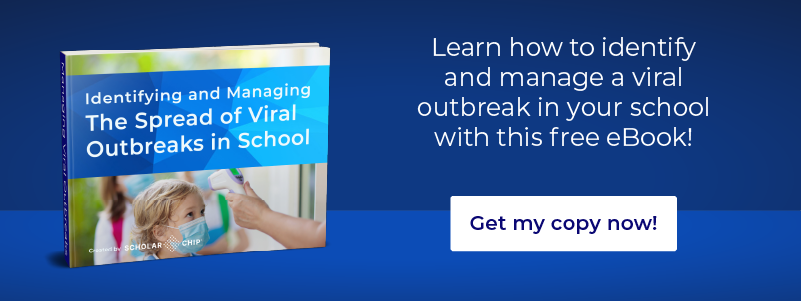Here’s a possible situation that could happen at one of your schools: A student comes to campus with mild symptoms of an illness. She moves from class to class, interacting with different peers in each classroom. Even though one of her teachers notices her mild cough, the student still stays in school through the day until her mother picks her up at the end of the day. A few days later, many students test positive for COVID-19. It turns out that the unwell student with minor symptoms had the virus and was quietly spreading it to fellow students. This scenario illustrates one of the worst ways that a school could have considered preparing for viral illnesses. At every turn, the school didn’t take appropriate precautions for minimizing the spread of COVID-19.
To avoid this nightmare situation, use the following tactics to diminish the impact of a sick student at your school.
Teach Students and Parents to Understand Symptoms in Children and Young Adults
A common myth about COVID-19 is that it only produces severe symptoms in those infected. This isn’t true, especially when it comes to young people. Children and teenagers may only display mild symptoms that may seem similar to colds or sore throats.
In pre-COVID-19 times, parents may have sent their children to school with mild illnesses. However, since COVID-19 can present as a minor illness in children, parents should keep home children who are even slightly sick.
Isolate Even Mildly Sick Students on Campus until They Can Be Picked Up
Students who present mild symptoms should be isolated away from others. This way, a sick student won’t keep spreading the virus, like the student in the example did.
Students should be taught to alert faculty and staff when they aren’t feeling well. Furthermore, faculty should monitor students who seem under the weather. These students should then be taken to isolation rooms where they can stay until they can be picked up. In times like these, it’s better to isolate students sick with colds or other mild illnesses, rather than risk widespread COVID-19 infection.
Stagger Your Students’ Class Schedules
Most classrooms are designed to pack in as many students as possible. Of course, with social distancing guidelines indicating that students should stay at least six feet away from one another at all times, traditional classroom setups are no longer feasible.
Instead, many schools are experimenting with staggered class schedules, where students attend part of the school day on campus and another part of the day online. This way, students can still have face-to-face contact with each other and their teachers without the risk of a tightly packed classroom.
Keep Students in the Same Cohort and Classroom for the Whole Day
The Centers for Disease Control and Prevention suggests that risk can be minimized if students are placed into cohort models. There are several components to this strategy. First, students should stay with the same group of students throughout the day. These groups should be small enough to allow for social distancing in the classroom.
Next, these students don’t move from classroom to classroom, which may involve close contact with students who aren’t in their cohort. Instead, teachers of various subjects come to them.
While this is an effective strategy for preparing for viral illnesses, it can be daunting to envision such complex scheduling. ScholarChip’s technology can help. Before staggering schedules, assign each student a One Card. It is equipped with a unique identifier for every student. Next, install Secure Door Access card readers at every classroom door.
With this technology, students can only enter classrooms where they’re assigned to attend class. A student’s card can’t open doors to rooms where they’re not supposed to be either. This way, students can only enter the rooms where they’re supposed to be when they’re supposed to be there.
Develop a Contact Tracing Team That Can Connect with Potentially Infected Students
If a sick student comes to campus, it’s vital to minimize their impact on others. The best way to do this is by creating a contact tracing team that can call students and staff who are in contact with the sick student, especially for extended periods.
ScholarChip’s One Card technology can be useful in simplifying this tracing. The necessity for students to use One Cards to enter locked classrooms provides information about the students’ whereabouts for the day. You can then use other One Card data to see which other students were with the infected student in the same space.
You can even do contact tracing for visitors to your campus. ScholarChip’s Visitor Management tracks each visitor who comes to your school. The system records when and for how long they were on campus, which in turn, helps you expand your contact tracing to visitors who may have contracted the virus from a sick student.
Since having a sick student on your campus is a worst-case scenario, you should spend time preparing for viral illnesses at your school. Instead of being reactionary to COVID-19, administrators should be proactive before an outbreak occurs. This way, a single sick student will be unlikely to spur a super-spreader event on your campus.
The ScholarChip team is dedicated to helping school leaders maximize the safety and well-being of students and the entire school community.
Now sure what you should do to be able to identify and manage the spread of a viral outbreak in your school or school district? Feel free to chat with one of our school crisis communication specialists today!


